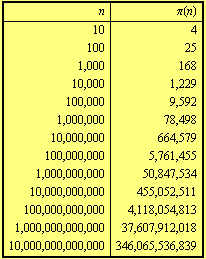 Main Index
Main Index
 Number Theory
Number Theory
 Arithmetic functions
Arithmetic functions
 Main Index
Main Index
 Number Theory
Number Theory
 Sequences
Sequences
 Primes
Primes
 Subject Index
Subject Index
 comment on the page
comment on the page
 Main Index
Main Index
 Number Theory
Number Theory
 Arithmetic functions
Arithmetic functions
 Main Index
Main Index
 Number Theory
Number Theory
 Sequences
Sequences
 Primes
Primes
 Subject Index
Subject Index
 comment on the page
comment on the page
The prime-counting function (or the prime number function) is the function counting the number of prime numbers  less than or equal to some real number
less than or equal to some real number ![]() . It is denoted by
. It is denoted by ![]() and
and ![]() denotes the number of primes less than or equal to
denotes the number of primes less than or equal to ![]() , that is
, that is
| (1) |
For instance, the primes under ![]() are 2, 3, 5, 7, 11, 13, 17, 19, 23, 29, 31, 37, 41, 43, 47, 53, 59, 61, 67, 71, 73, 79, 83, 89, and 97 so
are 2, 3, 5, 7, 11, 13, 17, 19, 23, 29, 31, 37, 41, 43, 47, 53, 59, 61, 67, 71, 73, 79, 83, 89, and 97 so ![]() . The following table shows the highly irregular character of the graph of the prime counting function
. The following table shows the highly irregular character of the graph of the prime counting function ![]() for values
for values ![]() .
.
![[Graphics:HTMLFiles/PrimeCountingFunction_12.gif]](HTMLFiles/PrimeCountingFunction_12.gif)
To compute some values of the prime-counting function go to  .
.
For bigger values of the argument we have the following values of the prime-counting function ![]() .
.

A simple lower bound for the prime-counting function gives the following result:
Theorem. For ![]() we have
we have
| (2) |
Proof. Consider the product
| (3) |
Every series in parentheses on the right hand is convergent, and there we can multiply then term by term. Therefore
| (4) |
where the dash denotes that the sum runs over those integers ![]() in which standard form appear only primes
in which standard form appear only primes ![]() . Therefore we have
. Therefore we have
![∑^' 1/n >= Underoverscript[∑, n <= x, arg3] 1/n > Underoverscript[∫, 1, arg3] 1/t d t > log x .](HTMLFiles/PrimeCountingFunction_23.gif)
On the other hand,
![Underscript[∏, p <= x, p a prime ] (1 - 1/p)^(-1) <= Underoverscript[∏, k = ... (x) · (π(x) + 1))/(1 · 2 · 3 · ... · π(x)) = π(x) + 1.](HTMLFiles/PrimeCountingFunction_24.gif)
The Theorem follows taking into account the proved inequalities.
Corollary. We have
| (5) |
that is, there are infinitely many prime numbers.
This result was for the first time proved by other means in Proposition 20 of Book IX of Euclid’s Elements.
Cite this web-page as:
Štefan Porubský: Prime-counting Function.